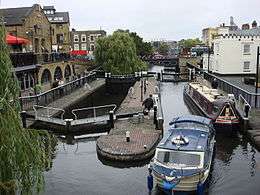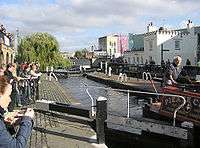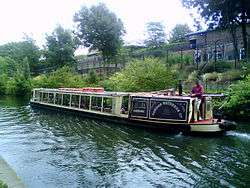Camden Lock
 The twin locks | |
| Waterway | Regent's Canal |
|---|---|
| County |
Camden Greater London |
| Maintained by | Canal & River Trust |
| Operation | Manual |
| Fall | 8 feet (2.4 m) |
| Distance to Limehouse Basin | 6.17 miles (9.9 km) |
| Distance to Paddington Basin | 2.77 miles (4.5 km) |
| Coordinates | 51°32′28″N 0°08′45″W / 51.5411°N 0.1457°WCoordinates: 51°32′28″N 0°08′45″W / 51.5411°N 0.1457°W |


Camden Lock is a small part of Camden Town, London Borough of Camden, England, which was formerly a wharf with stables on the Regent's Canal. It is immediately to the north of Hampstead Road Locks, a twin manually operated lock. The twin locks together are "Hampstead Road Lock 1"; each bears a sign so marked. Hawley Lock and Kentish Town Lock are a short distance away to the east, while to the west there is a long level pound, and it is 27 miles (43 km) to the next lock.[1]
History
Regent's Canal was authorised by an Act of Parliament obtained on 13 July 1812, for a canal from Paddington to Limehouse.[2] When the directors first met, they had decided that all locks would be paired, so that some of the water from a lock emptying could be used to fill the adjacent chamber. Water saving was an important factor, as they knew that water supply would be problematic. Colonel William Congreve, a military engineer who was later knighted, proposed the use of hydropneumatic boat lifts instead of locks. Various designs of a similar nature had been tried in the early nineteenth century, notably at Mells on the Dorset and Somerset Canal and at Tardebigge on the Worcester and Birmingham Canal, but none had proved successful.[3] Congreve's design used two water-filled caissons, which were moved up and down by hand, assisted by compressed air trapped beneath the tanks. With no working examples of such lifts, the directors were understandably cautious, but following an engineer's report, decided that Maudslay & Co should build a prototype at Camden Town.[4] There were a number of technical problems, with the canal company blaming Maudslays for poor design, and Maudslays blaming the canal company for changing the original design and failing to maintain the structure. Congreve's claim that it could be operated in just three minutes was never proved, and in 1818, the directors decided to cut their losses, and reverted to using paired locks. The lift was sold at auction in November 1919, and the 13 lots raised just £404.[5]
Construction of the canal was overseen by architect John Nash, with James Morgan acting as supervising engineer. Hampstead Road Locks were built between 1818 and 1820, with the chambers made of brick and stone coping along the top. The two locks are arranged side by side, with an island platform between them. Each chamber has two gates at both ends, and they have been Grade II listed since 1992.[6] They were the first of 12 pairs of similar locks which dropped the level of the canal by 96 feet (29 m) to reach Limehouse Basin.[7] The transfer of water between the chambers made operation of the locks more complex, and so they were permanently manned during the heyday of the canal, with lock-keepers working a shift system to provide 24-hour cover. As the use of the canal declined, in part due to railway competition, manning levels were reduced, and padlocks were used to prevent operation of the locks at the weekends. Following the end of commercial traffic and the growth of leisure boating, the locks reverted to operation by boat crews, and in order to prevent flooding caused by incorrect operation of the paddles, in the 1980s most of the pairs were converted to single locks, by replacing the lower gates of one chamber with a fixed weir. Hampstead Road Lock is the only one where both chambers have been retained, although they are now emptied conventionally.[8] In November 2013, the locks were fully drained for maintenance; the public were invited for the weekend of the 16th and 17th of that month to see the infrastructure for themselves.[9]
The lock is to the west of the Camden High Street road bridge. When the canal was built, the road was carried over it by a brick bridge, but this was found to be inadequate, and was replaced by a cast iron girder bridge in 1878. The cost was met by the St Pancras Vestry and the Metropolitan Board of Works, and the bridge, which has brick abutments with stone coping, carries a plaque recording this fact. Like the lock, it is Grade II listed.[10] At the south-east corner of the lock is a building dating from 1815, which was originally constructed to house air compressors for Congreve's boat lift. It was subsequently used as the lock keeper's cottage, and by 2010 had become a Starbucks coffee shop. The building was extended in 1975, when it was also stuccoed, and a crenellated parapet was added.[5][11] To the west of the lock is a cast iron roving bridge, dating from the early or mid nineteenth century. It had wrought iron tension stays when built, but these were replaced by steel cables in the late twentieth century, when the deck was also replaced.[12] The towpath is on the northern bank of the canal at this point, and is carried over the entrance to a dock which formed part of Camden Goods Depot by a cast iron single span bridge with stone capped abutments. It was constructed by J Deeley and Co, of Newport in Monmouthshire between 1848 and 1856. The granite setts which form the approach ramps were taken up and relaid in 1978.[13]
Camden Goods Depot
Camden Goods Depot was the London freight terminus of the London and Birmingham Railway, the first inter-city railway to reach London. Robert Stephenson was the engineer in charge of the project, and he picked the site for the goods depot so that direct interchange with the Regent's Canal was available, from where it could reach the London docks. A 25-acre (10 ha) site on the north bank of the canal was obtained from Lord Southampton in January 1937, and the goods depot was completed in 1839. Major features were a stationary winding engine house, which was used to pull trains up the incline from Euston to Camden, a shed for stabling of locomotives, 18 coke ovens which were used to make smokeless fuel, two goods sheds, stables for 50 horses, a wagon repair shop, and various ancillary buildings. Much of the site was supported on brick vaults. Pickfords, the public carrier, built a warehouse on the south bank of the canal in 1841. It was designed by William Cubitt, was extended in 1846, and was the first rail, road and canal interchange building in Britain, being linked to the goods depot by a wooden railway bridge over the canal.[14]
In 1846, the London and Birmingham Railway merged with several other railway companies to become the London and North Western Railway (LNWR). Just prior to the merger, they decided to build their own interchange facilities, rather than using Pickfords, and this was carried out by the LNWR. Semple's Wharf, on the north bank of the canal, was purchased, and the towpath bridge was built by 1846. A basin and dock were built once the sale of the wharf was completed in 1847, and a new rail link to the goods depot was added. As part of this expansion, two new engine sheds were built, one to the north of the tracks for goods engines, and one to the south for passenger engines. The southern shed was demolished in 1966, but the northern one, known as the Roundhouse, is Grade II* listed. A second wooden railway bridge crossed the canal to the former Pickfords warehouse.[14]
Following the construction on lines to link to the East India and West India Docks in 1851, which became the North London Railway in 1853, further upgrading of the goods depot was necessary to cope with the volumes of traffic. This took place between 1854 and 1856, and included the enlargement and realignment of the canal basin. When completed, it was 210 by 45 feet (64 by 14 m) with railway tracks on both sides running to the edge of the canal. Four new stable blocks were built next to the Hampstead Road, and the complex was linked to the marshalling yards by the Eastern Horse Tunnel. A Western Horse Tunnel was also build to link the goods depot to new stables near the present Gloucester Avenue, to the west of the mainline tracks. In 1864, the LNWR built a new goods shed, at the time the largest in the country, and in 1876, additional stables were built to the north of Gloucester Avenue. Access to the Western Horse Tunnel was by a set of horse stairs, which have survived. The LNWR good shed was enlarged in 1931, but subsequently demolished. The goods depot closed around 1980, and many of the stables were demolished in 2000. The Interchange Warehouse was remodelled in 1989, to become offices, and further restoration work occurred in 2007, when some of the later additions were removed. It is now known as The Interchange.[14]
Despite some demolition, the complex of buildings, which includes parts of the goods depot, the winding engine house, the Roundhouse, the eastern portal of Primrose Hill railway tunnel, and the canal, represent one of the most important groupings of nineteenth century transport infrastructure to have survived in Britain. The survival of the horse tunnel and stairs shows the importance of horse-drawn transport in the developing railway system.[14]
Camden Lock
Commercial traffic on the Regent's Canal had almost ceased by the late 1960s, and the transition to it being a leisure facility began soon afterwards. The towpath through the area of Hampstead Road Locks was upgraded and a formal opening was held on 20 May 1972. The lock keeper's cottage was refurbished, and transformed into an information centre and a coffee shop. The yard to the north of the locks, which had been Dingwall's timber yard, was bought by a property company in the early 1970s, and once the buildings had been modernised, they were rented out as craft workshops. It was at this point that the area was branded as Camden Lock, and as the workshops thrived, the retail market spread outwards. The former Dingwall's yard is now known as Camden Lock Market, and is one of a group of five markets in the vicinity which are collectively called Camden Market. It is a busy market which attracts many visitors, and with music venues, cafes and canal towpath walks, it has become one of London's most popular tourist destinations.[15] There are a number of art installations in the area,[16] including a large cut-steel sculpture by English artist Edward Dutkiewicz in the square beside the lock.[17]
Cultural references
- Camden Lock was well known in the UK as the address of TV-am the former ITV Breakfast Television franchisee in the 1980s and early 1990s.[18] The address was often displayed on screen for the purpose of correspondence.
- The main spaceship in the British television science fiction sitcom Hyperdrive, which was screened in 2006 and 2007, is called HMS Camden Lock.[19]
- The Italian band Modena City Ramblers wrote a song "Notturno, Camden Lock", with a lyric relating to Camden town where one of the band members lived, on their 1998 album "Raccolti".[20]
- In 2005, Kate Winslet appeared in a television commercial for American Express, strolling around Camden Lock. It was part of a campaign called "My Life, My Card", and in the commercial, Winslet referred to many of the events that have occurred to the characters she has played in films.[21]
- The American band Small Town No Airport, who were based in Massachusetts, recorded a song titled "Camden Locke" on their self-titled 1992 release. The song's lyrics included the line "I met a girl down at Camden Locks she was selling pictures that she drew with chalks...".[22]
- Camden Lock is one of many landmarks in this area of London to have a corresponding structure underground in Lawrence Leonard's fantasy novel for children, The Horn of Mortal Danger (1980).
- The Russian band Aquarium mentions Camden Lock in its song "Garçon Number Two".
- In series 3 of British television comedy The League of Gentlemen, Legz Akimbo Theatre Company member Phil and his friend Tish stroll around Camden Lock. Tish comments "Camden's such a rip off, I love it".
- The Japanese rock duo B'z re-recorded the song "Guitar Kids Rhapsody" from their second album Off the Lock. The song is referred to as "Camden Lock Style" because the music video for the re-recorded version was shot in and around Camden Lock.
Transport

A regular waterbus service operates from Camden, heading westwards around Regent's Park, calling at London Zoo and on towards Little Venice. Three of the four boats in use in 2016 were historic vessels on the National Register of Historic Ships.[23]
The tow path is open to pedestrians and cyclists.
The nearest London Underground station is Camden Town on the Northern line. The nearest London Overground station is Camden Road station.
Bibliography
- Camden (January 2001). "Regents Canal Conservation Area Statement". Camden Council.
- Cumberlidge, Jane (2009). Inland Waterways of Great Britain (8th Ed.). Imray Laurie Norie and Wilson. ISBN 978-1-84623-010-3.
- Darley, Peter (2013). Camden Goods Station Through Time. Amberley Publishing. ISBN 978-1-4456-2204-0.
- Hadfield, Charles (1970). The Canals of the East Midlands. David and Charles. ISBN 978-0-7153-4871-0.
- Nicholson (2006). Nicholson Guides Vol 1: Grand Union, Oxford & the South East. Harper Collins. ISBN 978-0-00-721109-8.
References
- ↑ Nicholson 2006, pp. 24-25.
- ↑ Hadfield 1970, p. 128.
- ↑ Hadfield 1970, p. 129.
- ↑ Hadfield 1970, pp. 129-130.
- 1 2 "Congreve's Hydro-Pneumatic Canal Lift – A Humbug!". London Canals. Retrieved 19 November 2016.
- ↑ Historic England. "Hampstead Road Lock (1272427)". National Heritage List for England.
- ↑ Cumberlidge 2009, p. 136.
- ↑ Camden 2001, p. 8.
- ↑ "Camden Lock drained and opened to public before restoration". BBC News. 16 November 2013. Retrieved 17 November 2013.
- ↑ Historic England. "Hampstead Road Bridge (1272426)". National Heritage List for England.
- ↑ Historic England. "Regents Canal Information Centre (1244300)". National Heritage List for England.
- ↑ Historic England. "Roving Bridge West of Hampstead Road Lock (1272428)". National Heritage List for England.
- ↑ Historic England. "The Interchange Canal Towpath Bridge (1113239)". National Heritage List for England.
- 1 2 3 4 Historic England. "The Interchange on North Side of Grand Union Canal Including the Horse Tunnel and Stairs, Vaults and Canal Basin (1113238)". National Heritage List for England.
- ↑ Darley 2013, pp. 89, 92.
- ↑ Darley 2013, p. 54.
- ↑ "Edward Dutkiewicz: Artist of stoic courage". The Independent. 18 December 2007.
- ↑ "TV-am Studios". TV-am archive and museum. Retrieved 4 November 2016.
- ↑ "Hyperdrive". IMDb. Retrieved 4 November 2016.
- ↑ "Raccolti (Versioni Live)". Amazon.
- ↑ "Kate Winslet Biography". Filmibeat. Retrieved 4 November 2016.
- ↑ "Artist: Small Town No Airport". Synthology. Retrieved 23 November 2016.
- ↑ "Little Venice - London Zoo - Camden Market". London Waterbus Co. Retrieved 21 November 2016.
See also
| Next lock upstream | Regent's Canal | Next lock downstream |
| None - Canal ends at Paddington Basin |
Camden Lock Grid reference: TQ286840 |
Hawley Lock No. 2 |
| Wikimedia Commons has media related to Hampstead Road Locks. |